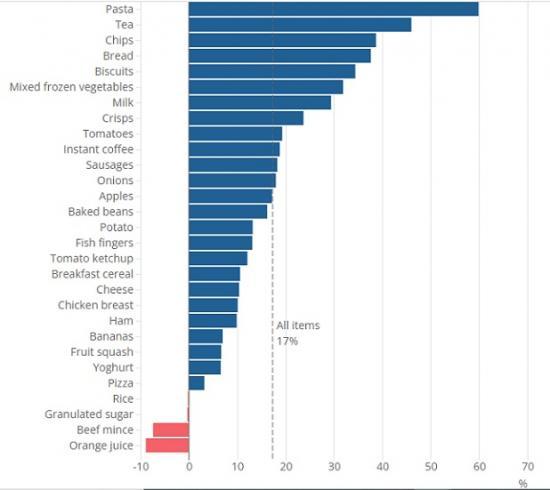Tracking The Price Of The Lowest-cost Grocery Items Uk Experimental Analysis April 2021 To September 2022
25th October 2022

How the prices of the lowest-cost products for 30 everyday items have changed since April 2021.
This from the Office for National Statistics.
Highly experimental research, based on web-scraped supermarket data for 30 everyday grocery items, shows that the lowest-priced items have increased in cost by around 17% over the 12 months to September 2022: an increase from 7% over the 12 months to April 2022.
Although not directly comparable, the rise in prices for the lowest-cost grocery items is similar to the 15% rise in the official measure of inflation for food and drink.
There is considerable variation across the 30 items, with the prices for four items falling between September 2021 and September 2022, but the prices of 15 items rising by 15% or more.
Vegetable oil showed the largest percentage increase and average price increase between April 2022 and September 2022, increasing 46% (80 pence per litre) during the period; in contrast, orange juice showed the largest decrease, decreasing 8% (6 pence per litre).
The data provided in this article remain highly experimental; we have updated the methodology used for the choice of substitutes for missing products, meaning estimates will differ from the previous publication of this data: more information on why we have chosen this approach is available in Section 9: Strengths and limitations.
Price movements for each grocery item
The lowest-priced everyday grocery items have seen a notable variation in price change, with some items showing increases of well over 20% from September 2021, while other items fell in price
For half of the 30 sampled items monitored (15 items), the average lowest price, across the retailers, increased at a faster rate than the latest available official consumer price inflation measure for food and non-alcoholic beverages (a 15% increase between September 2021 and September 2022). Caution should be taken when comparing with the official measure of consumer price inflation for food and non-alcoholic beverages, as it contains many more than the 30 items used in this analysis as well as using different aggregation methodology.
For nine items, the lowest-cost price increased by more than 20% since September 2021, and for three of those nine items the lowest-cost price rose by 40% or more. The items where the lowest prices rose at the fastest rate between September 2021 and September 2022 were:
Vegetable oil (65%)
Pasta (60%)
Tea (46%)
For four of the 30 items, the lowest prices fell on average during the same period. The largest price decrease measured was for fruit orange juice with an 9% fall in price, followed by beef mince which saw an 7% decrease.
It is important to consider that for each of the 30 items, the overall figure can be made up of different price movements at the product level. This includes when we are missing product-level price data, for a retailer, the cheapest product could be replaced with a more expensive item for a number of months before returning to track the original lowest priced item.
Another example is vegetable oil (including sunflower oil and rapeseed oil) where prices rose by 65%. However, for vegetable oil, there are instances where we are missing some product-level price data, at some retailers, for the cheapest oils. In one case, this caused us to track the price of a more expensive oil. For these reasons, the estimate of 65% should be treated with additional caution.
Between April 2022 and September 2022, the three largest average price rises in cash terms were:
Vegetable oil (up 80 pence for 1 litre to £2.58)
Chips (up 27 pence to £1.37 for 1.5kg)
Milk (up 25 pence to £1.52 for 4 pints)
In contrast, the largest average fall in the lowest averages prices measured between April 2022 and September 2022 were:
Fruit orange juice (down 6 pence to 76 pence for 1 litre)
Beef mince (down 5 pence to £1.95 pence for 500g)
To read much more information on many products and several charts go HERE
